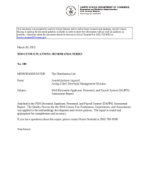2010 Decennial Applicant, Personnel, and Payroll System Assessment
2010 Decennial Applicant, Personnel, and Payroll System Assessment
Executive Summary
The Decennial Applicant, Personnel, and Payroll System (DAPPS) is a commercial off-the-shelf software from Oracle/Peoplesoft. It was customized to meet unique decennial requirements and interfaces with internal and other Federal agencies’ administrative systems. The DAPPS is a fully integrated system that focused on the following areas: recruitment, personnel data, time and attendance, and payroll. The system was developed by the U.S. Census Bureau to support the administrative work in the local and regional field offices established to manage the data collection operations associated with the 2010 Census.
The original plan for the DAPPS infrastructure supporting the 2010 Census was to be hosted under the Field Data Collection Automation contract; however, to minimize risks, the Census Bureau decided in the summer of 2008 to take ownership of the Field Data Collection Automation hosting requirement and move it to the Census Bureau infrastructure that went live on October 2, 2008. A location change was made to avert possible schedule delays that may have resulted from the contractor not being able to obtain a full certification and accreditation from IT Security for the data center. The new plan was to host the DAPPS system within the Census Bureau’s Bowie Computer Center using the Field Data Collection Automation hardware. The DAPPS team created an aggressive three-month schedule to transition, implement, test, and roll-out the new DAPPS infrastructure needed to support the 2010 Census by October 1, 2008. The DAPPS team in collaboration with the Decennial Systems and Processing Office, LAN Technology Support Office, Information Systems Support & Review Office, and the Telecommunications Office successfully placed DAPPS in production on schedule.
During the Address Canvassing operation, daily time and expense data were captured on the hand held devices used by the field staff and transmitted to the Early Local Census Offices for processing. After the Address Canvassing operation was completed in June 2009, all temporary field staff used the paper form D-308, Daily Pay and Work Record, to submit their hours and expenses. DAPPS employees received their initial paycheck eleven days after the close of the pay period in which they were hired and every seven days thereafter.
The DAPPS supported the processing and data capture of approximately 3.9 million job applicants ; supported the hiring of 857,374 employees; and supported a peak payroll of 585,729 employees in one week. On May 4, 2010, the DAPPS supported over 8,000 concurrent users who performed the necessary administrative functions to facilitate the hiring, training, and payroll of the temporary workforce needed to conduct the Nonresponse Followup operation.
The total life cycle costs for developing the DAPPS through the decade was $52.2 million.
Others in Series
Publication
Publication
Publication




